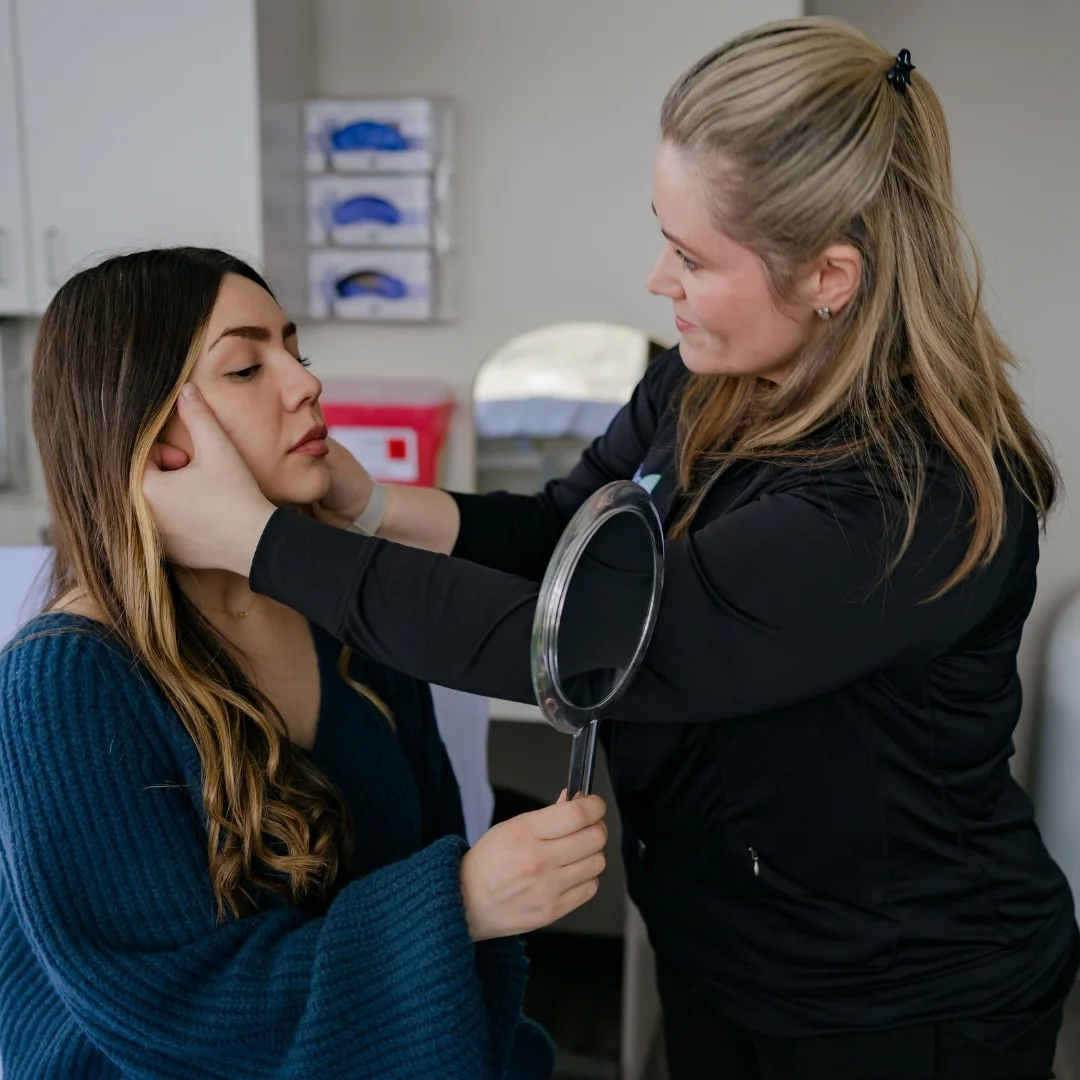
Photodynamic Therapy
Treat Skin Conditions with Light-Activated Medications in Denver
Light can do more than brighten your day — it can also help heal your skin. Photodynamic therapy (PDT) is an innovative treatment that combines light and specialized medications to target and eliminate skin conditions like acne, actinic keratoses and even some forms of skin cancer.
Dr. Joel Cohen and the AboutSkin Dermatology team have actively used photodynamic therapy in Denver for years. Not only have they applied it to great effect to treat a range of medical dermatology conditions, but they have also been heavily involved with clinical trials on this innovative technology.
What Is Photodynamic Therapy?
Photodynamic therapy (PDT) is a two-part treatment:
- First, a photo-reactive drug, known as a photosensitizing compound, is applied topically, covering the treatment area. The compound is left to absorb into the skin for a set amount of time based on the condition being treated.
- Second, the compound is exposed to light made up of specific wavelengths, typically in the red range. This “activates” the compound, causing it to release reactive oxygen species that kill the damaged or diseased cells in the treatment area. This process eliminates abnormal cells while stimulating the body’s natural healing mechanisms.

What Does Photodynamic Therapy Treat?
Photodynamic therapy is versatile and can address several skin concerns, both medical and cosmetic. Common conditions treated with PDT include:
- Actinic keratoses (pre-cancerous skin lesions)
- Superficial basal cell carcinoma (a form of skin cancer)
- Acne, including inflammatory acne
- Cosmetic skin concerns, such as sun damage and uneven texture
Actinic Keratoses
Because of the way the light-activated photosynthesizing compound works, photodynamic therapy is especially effective on lesions known as actinic keratoses. These are considered to be “pre-cancerous” lesions that form in areas that have experienced significant cumulative sun exposure and damage. Once activated, the photosynthesizing compound kills the cells that make up the lesion.
Superficial Basal Cell Carcinoma (BCC)
AboutSkin was part of the trial that successfully explored photodynamic therapy as a treatment for superficial basal cell carcinoma, the most common form of skin cancer. Known as BCC, this cancer grows slowly, but early detection and rapid treatment are still imperative. If left undiagnosed and untreated, BCC can grow beyond the skin, impacting muscle tissue, nearby nerves and underlying bones.
Acne
Photodynamic therapy can also be used to treat acne. The activated compound kills the P. acnes bacteria responsible for flare-ups of comedones (whiteheads and blackheads), papules, pustules and more severe nodes and cysts.
Cosmetic Skin Concerns
For patients seeking rejuvenated skin for cosmetic reasons, photodynamic therapy can be used in conjunction with other light therapies, such as BroadBand Light (BBL) and intense pulsed light (IPL).

What PDT Treatments Are Available?
Photosensitizing Compounds
Several photosensitizing compounds are available for use in photodynamic therapy, with different compounds targeting different conditions. One commonly used compound is aminolevulinic acid (ALA), which is effective for treating actinic keratoses and basal cell carcinoma. A specific formulation of ALA is Ameluz, an aminolevulinic acid hydrochloride gel. Amulez is activated by both BLU-U® and BF-RhodoLED® lamps to treat mildly to moderately severe actinic keratoses on the face, scalp, arms and chest. The wavelength used for this treatment is either the blue or the red portion of the spectrum, depending on the severity of disease.
Light Activation
- Blue light: Effective for superficial skin conditions like acne and actinic keratoses
- Red light: Penetrates deeper into the skin and is used for more severe or deeper lesions, such as basal cell carcinoma
What to Expect After Photodynamic Therapy
Common PDT Side Effects
The treated skin may redden, itch and scale after photodynamic therapy. The area may develop a crust, which will gradually flake off over the next few days. These side effects typically last for up to four days, though they may persist for one or two weeks or longer, depending on the intensity of the treatment and your skin’s healing process.
After the crusts flake away, the underlying skin should appear and feel smooth.
Photodynamic Therapy Recovery and Downtime
Skin treated with photodynamic therapy is especially sensitive to subsequent sun exposure. Patients should avoid ultraviolet (UV) radiation from the sun or any other source for at least 48 hours following a treatment session. It’s recommended to stay indoors and wear broad-spectrum sunscreen when venturing outside during this period.
Photodynamic Therapy Results
As the skin heals, you’ll notice improvements in the treated area. Actinic keratoses will diminish, acne lesions will fade and any damaged cells will be replaced with healthier skin. The final results should be visible once the healing process is complete, leaving smoother, clearer skin.
How Long Do Photodynamic Therapy Results Last?
The longevity of your results will depend on the condition being treated and how well you care for and protect your skin after the procedure. For acne treatments, results can last several months, though maintenance treatments may be necessary for long-term control. For actinic keratoses and basal cell carcinoma, photodynamic therapy can offer long-lasting results, especially when combined with proper sun protection and regular dermatological checkups.
Shine a Light on Healthier Skin With PDT in Denver
Because photodynamic therapy is a powerful solution to several medical and cosmetic problems, it is important to meet with a Board-Certified Dermatologist to determine whether the treatment is ideal for a given condition. The treatment should be administered only by a trained and experienced medical professional.
Contact AboutSkin Dermatology and Aesthetics to discuss any skin concerns and arrange for a consultation to find an effective and safe solution. Call 303-756-7546 or contact us online today to book your appointment.

Pinpoint Skin Issues From Home
With AboutSkin’s virtual consultations, you can easily highlight specific skin concerns on your face or body and connect with a dermatology professional. Receive personalized guidance and a custom care plan—all from the comfort of home. Schedule your consultation today!

Patient Testimonials
Let Your Skin Glow
Let Your Skin Glow
Let Your Skin Glow
Let Your Skin Glow
Let Your Skin Glow
Tag us on Instagram @aboutskindermatology
Book Your Consultation Today
By clicking submit you consent for us to contact you by phone, text or email using to the data provided, even if the contact info is on a state or national DNC list. You also consent to our Privacy Policy and Terms of Service.
Greenwood Village Office
5340 South Quebec ST., STE. 300 (South Entrance)
Greenwood Village, CO 80111